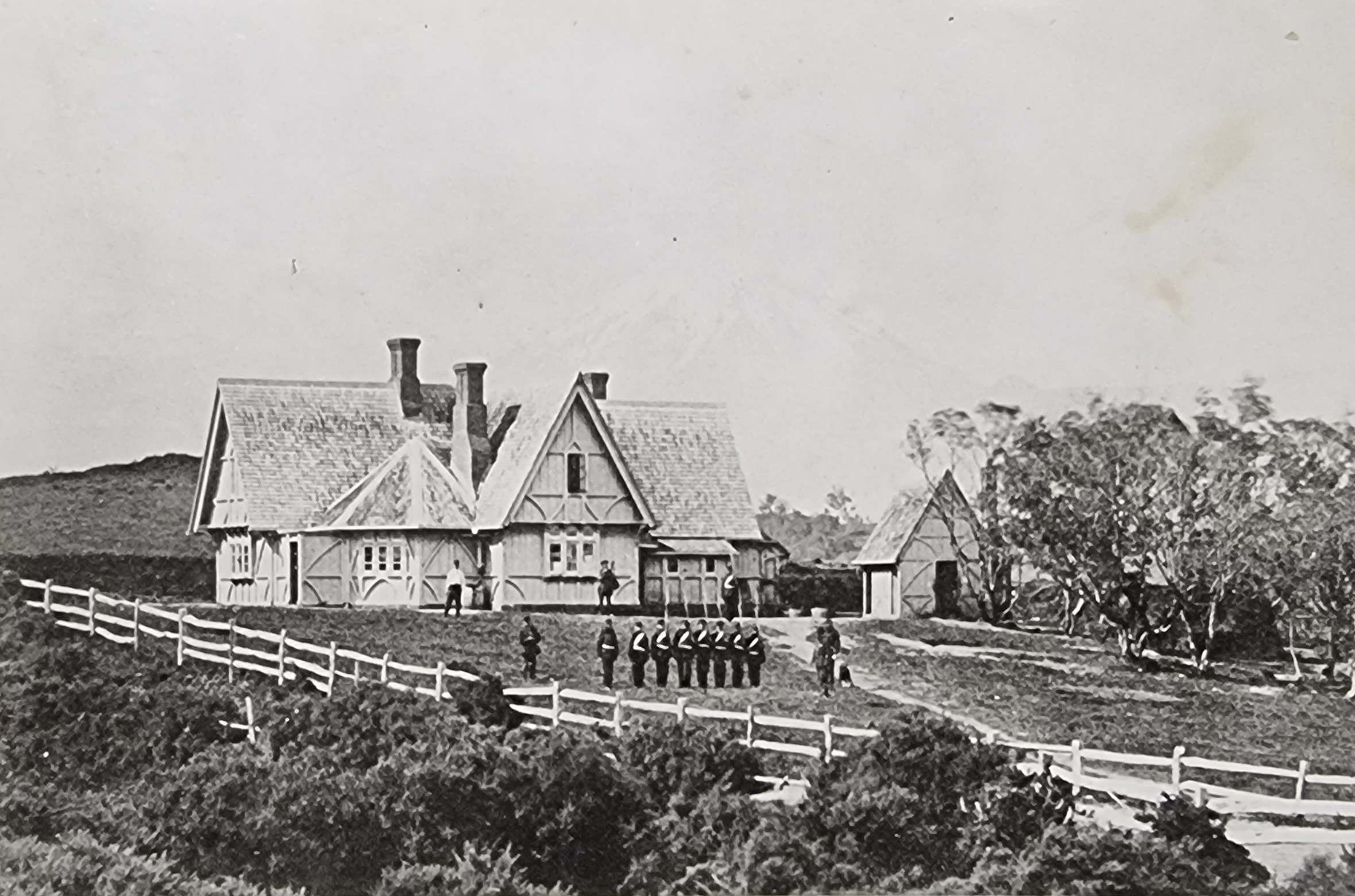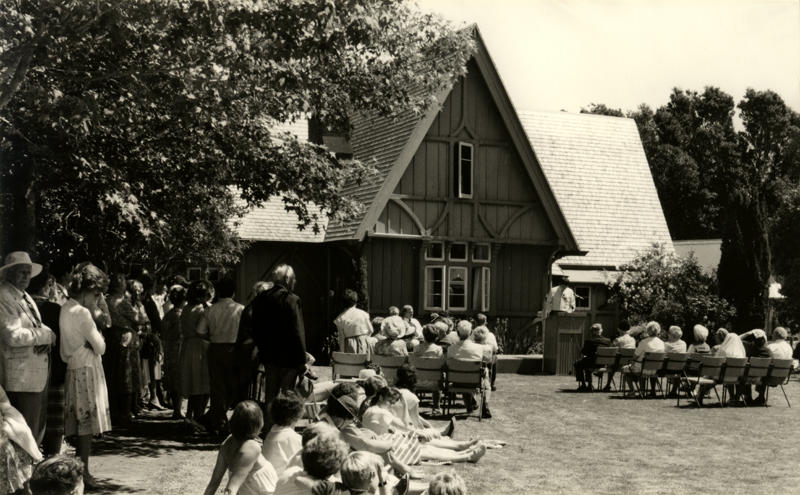PUKEKURA PARK - THE GABLES
The Story of The Gables – Audio
The Gables was originally built in 1848 as one of four Colonial Hospitals commissioned by Governor Sir George Grey, that were built to cater for both Maori and European patients. The building was designed by Frederick Thatcher and built by local builder George Robinson. The building was constructed using Rimu except for the floor, which was Norway spruce.
The hospital was originally located at Mangorei Road (then Hospital Road) where New Plymouth Girls High School now stands. It was mainly used by Maori, but after Rawiri Waiaua died there due to a gunshot wound received during an intertribal affray in 1854, Maori were reluctant to use it. The hospital was also not popular as it was very cold in the winter

The Old Colonial Hospital - 1860s
Puke Ariki ARC2004-248
During the Taranaki Wars of the 1860s the building was used as a military outpost after which it reverted to being a hospital. By the turn of the century, under the governance of the Taranaki Hospital and Charitable Aid Board, the building had become an old man’s refuge housing five residents. The men were left to look after themselves and the property became dirty and neglected, and in 1903 a decision was made to move the residents to better accommodation. Not knowing what to do with the property the Hospital Board approached the Borough Council and suggested swapping the land that the hospital occupied for six town sections (404 – 409) on Fulford and Dawson Streets. After the exchange the Council assessed the old hospital building as not being of use to them and decided to sell it at auction for removal.

The Refuge - Old Man's Home
Auckland Weekly News, July 12, 1901
Before the exchange the building had been inspected and found to be solid except for the ground plates, and the Hospital Board said that it would help to accommodate anyone interested in saving the building. W. H. Skinner called a public meeting on behalf the Scenery Preservation Society to see if that was possible, unfortunately nothing came of it.
The old hospital went to auction on July 9, 1904, at the Newton King auction rooms with the stipulation that it had to be removed within 14 days. The highest bidder was published as being a “well-known ‘house breaker’”. Following the auction Newton King ultimately must have negotiated the purchase of the old hospital from that gentleman. It is said that Mrs. King, daughter of Doctor George St George was the person who wanted to save the building. It was purchased for £10, then a further £500 was spent on its relocation and rebuilding.

The Gables in the 1960s
Puke Ariki PHO2012-0029
The transfer of the building would have been complicated as it was taken down piecemeal and all the timbers thoroughly cleaned and restored before re-erection at its current site at Brooklands. Newton King engaged the services of prominent local architect of the time, James Sanderson to supervise the house relocation.
Following the erection of the building at Brooklands it was used as a temporary residence by several members of the King family, as well as being rented out privately. When Brooklands was gifted to the city of New Plymouth in 1933 The Gables as it had become known, was part of the package. Again, it was let out to private renters until 1983. Following a two-year restoration, it was opened as an Arts Centre in 1985.
It is now regarded
as a building of national significance and has a category I rating with the New
Zealand Historic Places Trust.

The Gables opening day as an Arts Centre - 1985
Puke Ariki PHO2014-0204

Map showing location of the colonial hospital next to Mangorei Road - Now the Girl's High School

The red circle highlights the location of where the Gables was located on Mangorei Road.
THE GABLES (TH, SEPTEMBER 9, 1933)
AN HISTORIC BUILDING – OLD COLONIAL HOSPITAL
There stands on the “Brooklands” property an historic building known as “The Gables.” This was originally known as “The Colonial Hospital” and its site was five acres of land between the Henui River and the Mangorei Road. In December, 1847, the newly appointed Governor of New Zealand, Sir George Grey, forwarded from Auckland a plan for a hospital to cost £700.
Reference to the hospital is found in Mr. W. H. Skinner’s recent work, “Pioneer Medical Men of Taranaki.” “The hospital building,” he says, “was designed by Mr. Thatcher, the same architect who drew up the plans for the original St. Mary’s Church, and the old Vicarage, Courtenay Street, Henui, and St. John’s Chapel, Tamaki, Auckland. The building certainly had a picturesque exterior, but as to the internal arrangements
we understand they were far from being convenient. From 1848 to 1860 the hospital was under the direction of Dr. Peter Wilson and was occupied by patients both European and Maori. Apart from the doctor the staff consisted of one male assistant, the late Thomas M’Guinness being the steward during the latter period of the institution’s occupation. A photograph of the building is reproduced.
“In a letter to Mr. Donald M’Lean, Native Secretary, Auckland, under date of January 25, 1858 Dr. Wilson states: ‘I send forward my annual list of ‘out and in’ patients for the past year. For a long time, i.e. ever since Rawini died within its walls, very few Maori patients have been admitted, and I understand the same diminution has been experienced at Wanganui. I begin, therefore, to think that the keeping up of the establishment is quite an unnecessary expense to the Government, and that it should be handed over to the Provincials who are so fond of all sorts of usurpations, and as white people frequent its wards as much as Maoris do.’
“On the outbreak of the Maori troubles in 1860 and the close investment of New Plymouth by the Natives, it became necessary to make other arrangements for hospital service. Every residence to the north of the Henui River, with the exception of the Anglican and Primitive Methodist Churches with their parsonages and the hospital, had been burnt by the insurgents. Included in this destruction was the residence of Dr. Wilson, situated on the north side of Devon Street, about one hundred yards eastward of Nobs’ Line. The hospital was probably spared, having became tapu by reason of one of the leading Maoris having died there, notably Rawini Waiana, the leading chief of the Puketapu people, who was brought into the hospital from the Corbett Road, Bell Block, after being mortally wounded in an attack by his countrymen on August 3, 1854, as protest, against his proposed sale to the Government of the Lower Tarurutangi block.
“Owing, as explained to the dangerous condition of the locality, use of the building as a hospital was abandoned and other arrangements were hurriedly made to meet the unexpected conditions that had arisen by the sudden outbreak of hostilities and the crowding in of the whole population of the country districts (Bell Block, Omata, Tarata, and from the Frankley, Carrington and Mangorei Roads) within the contracted defensive lines of the town. To meet this urgent need, a building situated on the corner of Brougham and Vivian Streets (site now occupied by a doctor’s residence) was commandeered by the authorities in the latter half of 1860. The ‘Colonial Hospital’ had in the meantime been taken over by the Military, and occupied as an outpost in defence of the town.”
In the late 90’s the land on which the “Colonial Hospital” stood was exchanged for the purpose of a secondary education reserve (where the New Plymouth Girls’ High School now stands) and the building was put up for removal. It was purchased by the late Mrs. Newton King, who wished to preserve an historic landmark. The building was demolished and re-erected on its present “Brooklands” site.
Note: Dismantled would be a better word to describe what happened to the building when it was moved rather than demolished as stated in the last paragraph.
The building was built by local builder George Robinson and when it was moved the relocation was supervised by architect James Sanderson.